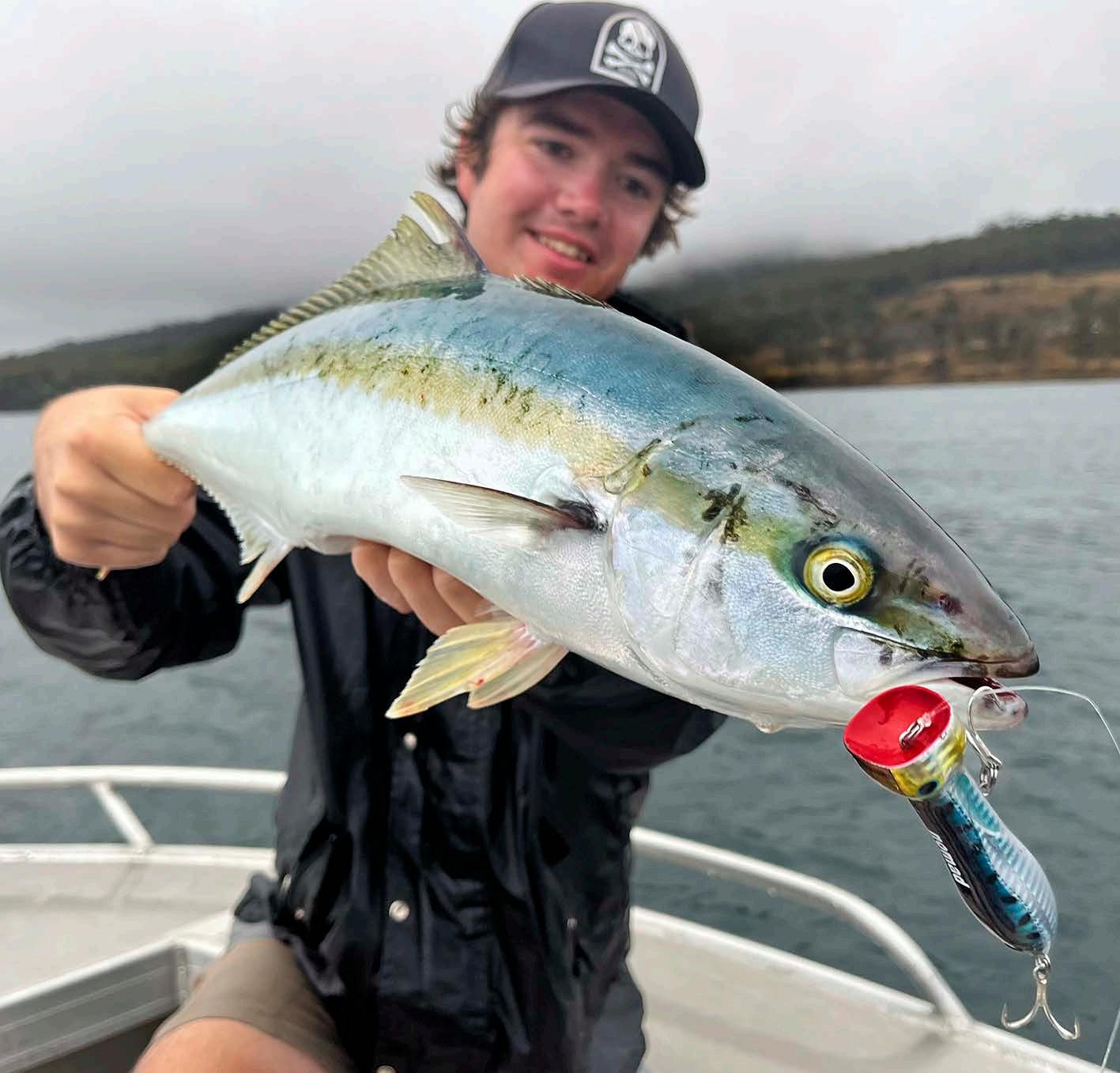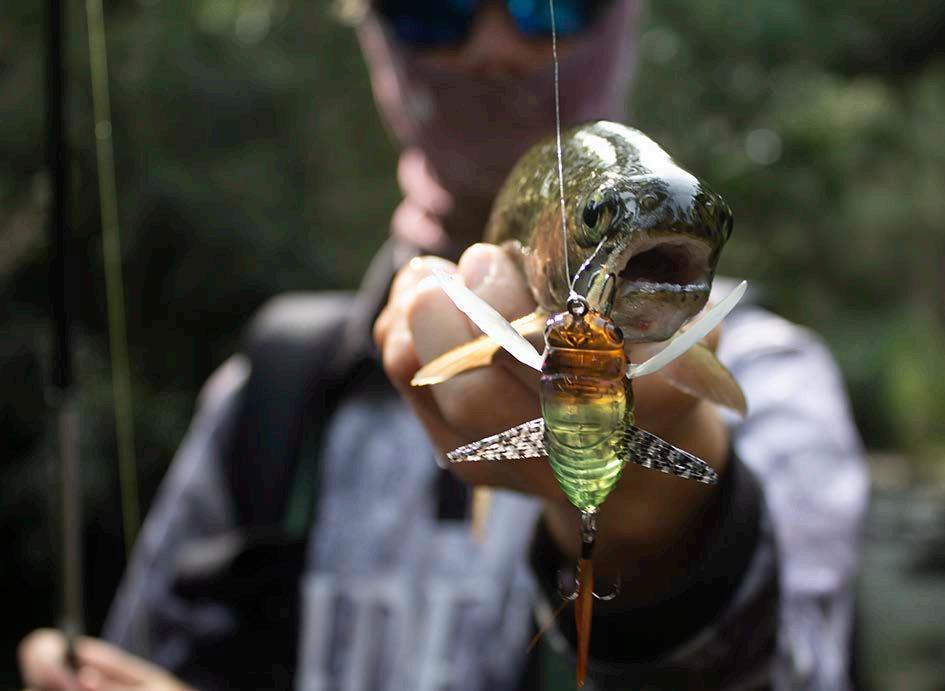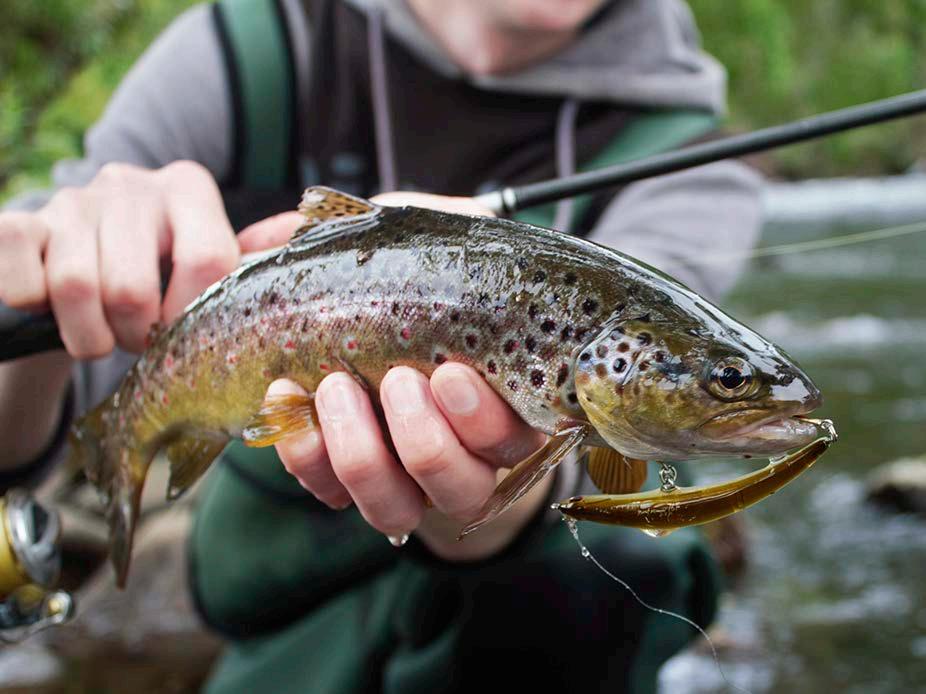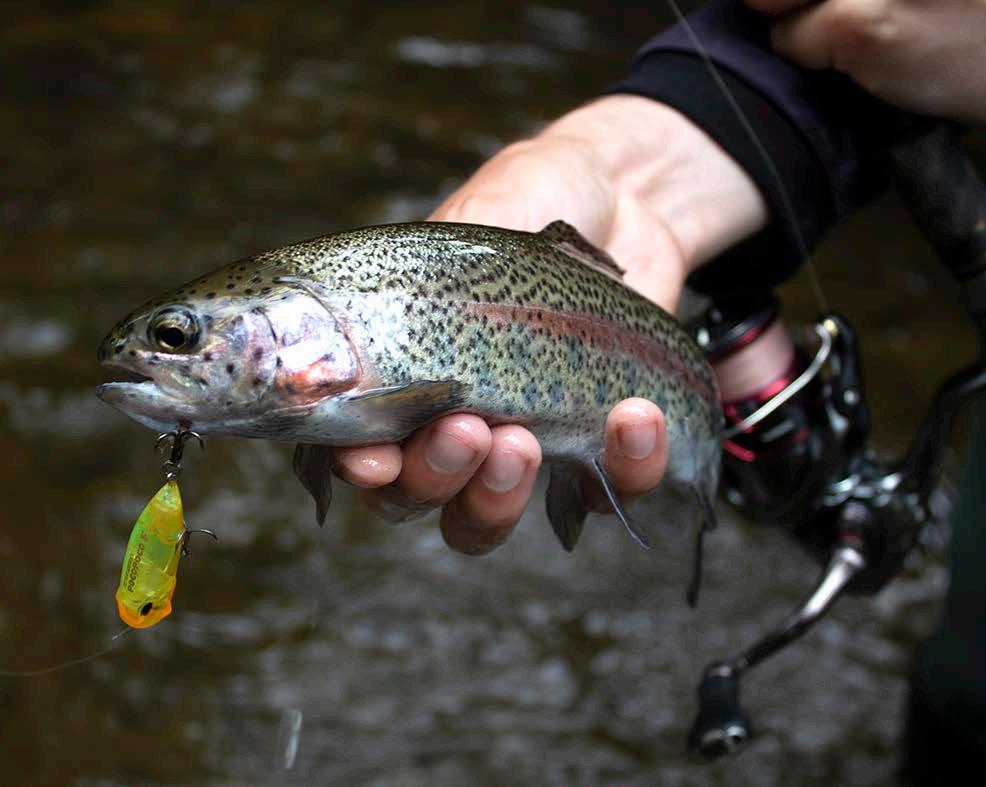
7 minute read
Top Water Tactics
Techniques for targeting Tassie’s top fish
Nathan Huizing
Yellowtail Kingfish
When it comes to fishing there is an endless list of methods and techniques that can be used but for me, there isn’t much, if anything, that beats topwater fishing. Not only is it a very engaging and at times a highly productive style of fishing, but the visual aspects are also second to none. The excitement of seeing that bow wave approaching your lure as a fish hones in on your presentation is one of the most addictive things you can witness. Tasmania has several great species that will readily take a topwater lure. In this article, I’ll cover a few of my favourites and some of the things I’ve learnt while chasing them!
One of, if not my favourite fish to target on topwater. Seeing a pack of hungry kings mow down a surface lure definitely gets the heart racing. From late November through till about the end of April, kingfish turn up in many of the bays and estuaries around the state and can also be found offshore around things such as floating kelp rafts and the several fish attracting devices (FAD’s) deployed around Tasmania.
Kings would have to be one of the most temperamental fish and at times fussy feeders you can chase. Because of this, I like to have a reasonable variety of lures with me when fishing for them. Some of my favourites include the Nomad Chug Norris 95, Dartwing 130, Riptide 125F and the OSP Bent Minnow 130 SW.
When searching for kings I like to concentrate my efforts around structure. Kings love hanging around things such as boat moorings, wharves, channel markers and salmon farms. These are all great places to start looking, although it pays to stay vigilant and keep an eye out for disturbances on the surface in open water. Even the slightest little ripple is worth investigating as these fish can often be found slowly mooching around sunning themselves just under the surface. Approaching these likely spots with stealth is also important and using an electric motor is great for this. Upon arrival at a spot, I like to cruise in slowly from 50m away and begin to work my way around the whole area thoroughly making long casts towards the structure and trying to draw any fish away from the structure with my retrieve.
As I mentioned, kings can be very temperamental and fussy so I like to mix up my retrieves and swap between lures every half hour or so until I find what they want. For example, there have been times when I have started with a stickbait and almost been convinced there were no fish in the area. Changing over to a popper and casting over the same spot I’d just been fishing for the last 30 minutes has quickly revealed that there is indeed fish there and something as simple as causing a bit more commotion with the lure is all it takes to provoke a strike. Other days, the opposite can have the same effect and the fish will react better to a more subtly retrieved lure. Another thing to pay attention to is how the fish are coming up and reacting to your lure. If they come up aggressively swiping at it, don’t change up your retrieve. However, if they come up and hang back behind the lure, mix up your retrieve. This is usually when I’ll pause the lure for a second or two and then twitch the lure aggressively for a couple of metres and repeat. The size of the gear you’re using really depends on the size of the fish you’re chasing but generally, the majority of kings you’re going to come across will be in the 50-70cm size class, particularly along the east coast. For these fish you don’t need much more than a 3000 or 4000 size reel, 3-6kg or 4-8kg rod, 10-20lb braid and 20-40lb leader. The lighter stuff is great for open water and the slightly heavier is more suited to fishing around structure.
Trout
Topwater Trout fishing is certainly nothing new and many anglers have heard about the monsters that used to be pulled from locations such as Lake Pedder many moons ago by fishermen using fish cakes of a night. While fish cakes still hold their own with many fishermen still using them successfully, over the last decade or so there has been a good variety of other great surface lures make their way onto the trout scene in Tasmania. Small cicada style lures, bent minnows, pencils and prop baits just to name a few. Topwater fishing will get results on all bodies of water from small stream s to larger rivers, lakes, dams and even on sea trout in the estuaries.



When fishing the smaller rivers and streams I usually opt for smaller lures in the 40-70mm range. Bent minnows and cicadas are great for this as they can be worked effectively with a steady retrieve downstream. Typically, I like to make a long cast upstream from where I’m standing and retrieve the lure at a speed that is just slightly faster than the water is moving. Bent minnows require a bit of rod movement to benefit from the erratic action they’re designed for. For this, I like to keep the rod tip low and apply a constant whippy action through the rod while winding steadily. As for the cicadas I’ve found a raised rod tip to help keep the line off the water while winding steadily gets these lures crawling nicely across the surface. When fishing these systems there are things you can do to increase your chances such as identifying likely ambushing spots for the fish. Things such as undercut banks, overhanging willows and submerged logs are all great spots to work your lures around.
The same lures, as well as pencils, prop baits and wake baits can be used when chasing trout in larger rivers, lakes and estuaries. Personally, I like to fish slightly larger lures in these systems. Offerings in the 70-120mm size will often be met with aggression from both large and small trout. Regardless of whether the water is flowing or you’re fishing still water, I think the key to topwater trout during the daytime is to keep your lure moving. From my experience, unlike some other species, trout will more often than not shy away from a surface lure if it is paused. That being said, I’ve found that a short pause in your retrieve at night time can actually encourage a strike, so it is worth experimenting! To add to that, topwater fishing at night is a great way to get yourself connected to larger fish that don’t often show themselves during the day.
Another thing to keep in mind is that trout are quite messy feeders when attacking a surface lure and will often swipe and headbutt your lures which results in a rather average hook up rate. Due to this, some lures can benefit from having the trebles replaced with assist hooks. However, the exciting visuals of a trout smashing your topwater lure is worth the poor conversion ratio in my opinion!

Bream
Another great light tackle option, bream love topwater lures and the best part is they can be caught on topwater all year round! During the warmer months, my favourite way to target these fish is by searching over the large sand flats and oyster racks which can be found in a number of estuary systems around the state. A few of my favourite topwater bream lures include the Bent Minnow 86, Nomad Dartwing 70 or the Maverick 68. When fishing the flats, if possible, set yourself up to drift with the sun behind your back. Add a decent pair of polarised sunglasses in the mix and you’ll be able to get a great view of your surroundings beneath the surface. When searching the flats, make long casts to cover as much water as possible. With the rod tip down, wind steadily while flicking the rod tip in a downwards motion to get the lure moving. This should get the lure zig-zagging across the surface. In most instances, the key to lure fishing for black bream is to incorporate several pauses into your retrieve. This is nearly always when the bream will grab your lure. I like to work the lure no more than a metre or two between each pause. It is worth experimenting with your pauses until you find what the fish want. Sometimes a short 2-3 second pause is all that is needed, other times a pause as long as 5-6 seconds can be what it takes to encourage a bite. When working your lure pay close attention to the water surrounding it. When a bream is interested in your presentation you will often see a bow wave forming behind the lure as the fish approaches. Other times a small boil will appear beside your lure as the fish investigates from beneath. When fishing things such as oyster racks, undercut banks or rock walls, try to cast parallel with the structure. This will keep your lure in the strike zone for the majority of the retrieve.
During winter and spring, the bream tend to congregate in smaller systems where they school up in large numbers. Although topwater fishing in winter is often less productive it still works nonetheless. In these smaller systems fish will usually school up along undercut banks and around fallen trees. As it comes into Spring these fish will begin to spawn. This is when they’re often found in the higher reaches of these systems. Applying longer pauses and working your lure slower is one of the main keys to success when fishing topwater in the cooler months. Pauses as long as 6-7 seconds and only moving your lure 30-50cm between pauses is what I’ve found to be most effective at this time of year.

Generally, when chasing bream on the surface I will fish with a 6lb leader over the flats and 8 or 10lb around structure such as oyster racks and timber. That being said, bream can be quite easy to spook at times, particularly in calm sunny conditions. This is when downsizing your leader to 3 or 4lb can benefit your catch rate.











